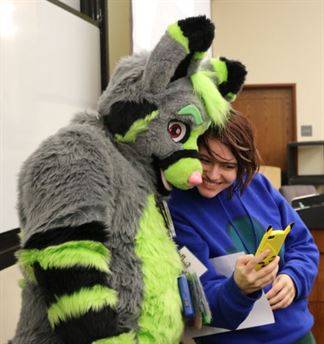Austin Greitz, a senior at Montclair State, seems just about as outgoing as anyone can be. He is majoring in gender, sexuality and women’s studies, and is a lavender leader, or peer educator, for the university’s LGBTQ Center. Greitz has soft, disarming features that anyone would be drawn to. But what most people don’t realize is that he’s introverted.
“At the end of the day, I really need to go back and spend a few hours by myself to kind of recharge,” he said. “It’s so draining for me to be out with people all day long. And so, I thought it would make sense for me to be a mouse.”
When Greitz talks about being a mouse, he isn’t using the traditional metaphor. He is talking about identifying with his fursona, Sassbucket.
Greitz is part of the furry fandom subculture, which is characterized by its interest in anthropomorphic animal characters, or animals that have human features and qualities—like being bipedal, having human intellects and having manifest emotions.
Some fans create “fursonas” like Sassbucket—original characters or avatars who represent their identity. Some masquerade as their fursonas with intricate costumes, or “fursuits,” which can be expensively priced, and some fans choose to sport only a pair of ears or a tail.
The subculture is stigmatized and widely misconceived, inextricably linked to sexual deviance and bestiality, though only a fraction of the fandom’s demographic engages in sexual activity within the subculture.
D. Felix, another lavender leader for the LGBTQ center, called the fandom “a lot of fun and family and cuteness.”
“At first I was really skeptical, because I didn’t know anything about [furries],” the Montclair State junior said. “But the more I did research on it, the more I fell in love with it. It’s a lot more than oversexualized characters.”
It’s puzzling that the furry fandom is branded as abnormal. Anthropomorphism has prevailed globally for millennia in history, literature and popular culture. Anubis, the Egyptian god associated with embalming and the afterlife, is often portrayed in art as a human with a wolf’s head.
Fairy tales like “Little Red Riding Hood” and fables like Aesop’s “The Tortoise and the Hare” also explore animals that have human-like features and psyches. Disney’s Academy-Award-winning “Zootopia” is comprised entirely of anthropomorphic animals who allegorize issues of race in modern society.
“Growing up, I was really into Disney,” Greitz said. “Maybe we can think of that as a predisposing factor.”
The furry fandom’s fascination with anthropomorphic animals extends beyond an appreciation for entertainment value—the characters, and fursonas, are a way to decipher and symbolize the human condition.
Chyanne Santana, a Montclair State student, is a newcomer to the fandom, but has already chosen her fursona.
“I definitely feel like wolves are a reflection of my identity,” she said. “I’m very independent and I love my family. I just always liked how they’re part of a pack.”
She is in the process of obtaining a tail and ears, and looks forward to wearing them with pride.
But not all members of the fandom wear full or even partial fursuits. Henri Reiher isn’t involved in the “activities,” of the fandom, but is primarily interested in the fandom’s artwork. He was introduced to the subculture through anime, or traditionally Japanese animation.
Reiher is polite and soft-spoken. As an illustrator, he is interested in comparing the characteristics of animation across different cultures and across different genres, and he likes to observe other artists through furry commentary videos on YouTube.
“In the Western genre, a lot of anthropomorphic characters are ‘cartoony,’” Reiher said thoughtfully. He described them as having “noodle-arms” and “simple-shaped bodies.”
Anime, and most of the predominate art in the furry fandom subculture, is highly detailed. The characters have much more complex features and human physicality. Reiher pointed to characters like King Kazma from “Summer Wars,” Lucario from “Pokemon,” and Renamon from “Digimon.”
When Reiher was introduced to the fandom, he, like many others, was hesitant. “I was at that sort of mental state where I thought that everything I was into online reflected what I was into in reality,” he said. “But what you’re into in the virtual world doesn’t always have to reflect what you like in the real world.”
Members of the fandom are eager to change the harsh criticism that the subculture is often met with. Grietz tries to generate a conversation by discussing it with his friends, introducing content in his media class, and hosting events like The Fursuit of Happiness.
The event included a Power Point presentation, a plush fursuit sample and coloring pages for people to design their own fursonas. Santana used her favorite colors, purple and black, to begin the concept of her wolf.
“People don’t talk about it and talking about it is a way to legitimize it,” Gretiz said. “This is a subculture that exists, and it’s really cool.”




